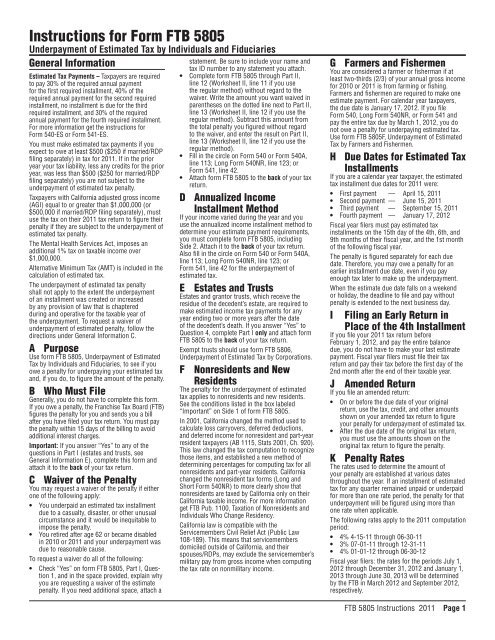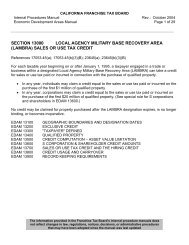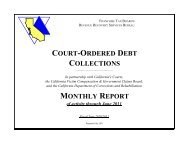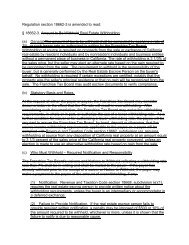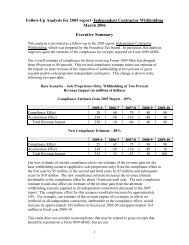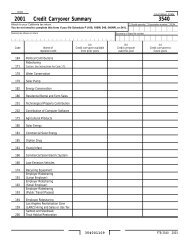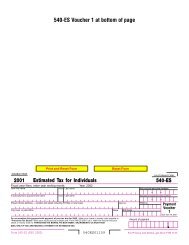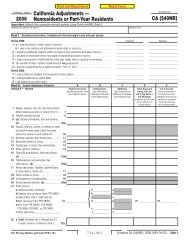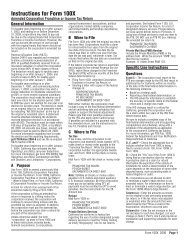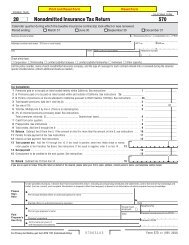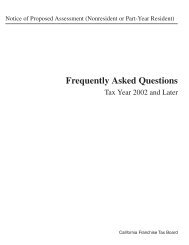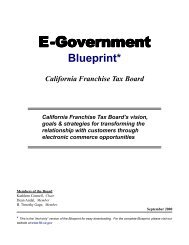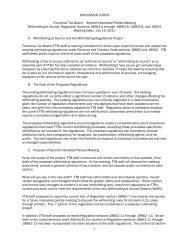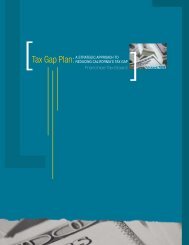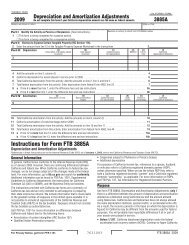Instructions For Form FTB 5805 - California Franchise Tax Board
Instructions For Form FTB 5805 - California Franchise Tax Board
Instructions For Form FTB 5805 - California Franchise Tax Board
You also want an ePaper? Increase the reach of your titles
YUMPU automatically turns print PDFs into web optimized ePapers that Google loves.
<strong>Instructions</strong> for <strong>For</strong>m <strong>FTB</strong> <strong>5805</strong><br />
Underpayment of Estimated <strong>Tax</strong> by Individuals and Fiduciaries<br />
General Information<br />
Estimated <strong>Tax</strong> Payments – <strong>Tax</strong>payers are required<br />
to pay 30% of the required annual payment<br />
for the first required installment, 40% of the<br />
required annual payment for the second required<br />
installment, no installment is due for the third<br />
required installment, and 30% of the required<br />
annual payment for the fourth required installment.<br />
<strong>For</strong> more information get the instructions for<br />
<strong>For</strong>m 540‑ES or <strong>For</strong>m 541‑ES.<br />
You must make estimated tax payments if you<br />
expect to owe at least $500 ($250 if married/RDP<br />
filing separately) in tax for 2011. If in the prior<br />
year your tax liability, less any credits for the prior<br />
year, was less than $500 ($250 for married/RDP<br />
filing separately) you are not subject to the<br />
underpayment of estimated tax penalty.<br />
<strong>Tax</strong>payers with <strong>California</strong> adjusted gross income<br />
(AGI) equal to or greater than $1,000,000 (or<br />
$500,000 if married/RDP filing separately), must<br />
use the tax on their 2011 tax return to figure their<br />
penalty if they are subject to the underpayment of<br />
estimated tax penalty.<br />
The Mental Health Services Act, imposes an<br />
additional 1% tax on taxable income over<br />
$1,000,000.<br />
Alternative Minimum <strong>Tax</strong> (AMT) is included in the<br />
calculation of estimated tax.<br />
The underpayment of estimated tax penalty<br />
shall not apply to the extent the underpayment<br />
of an installment was created or increased<br />
by any provision of law that is chaptered<br />
during and operative for the taxable year of<br />
the underpayment. To request a waiver of<br />
underpayment of estimated penalty, follow the<br />
directions under General Information C.<br />
A Purpose<br />
Use form <strong>FTB</strong> <strong>5805</strong>, Underpayment of Estimated<br />
<strong>Tax</strong> by Individuals and Fiduciaries, to see if you<br />
owe a penalty for underpaying your estimated tax<br />
and, if you do, to figure the amount of the penalty.<br />
B Who Must File<br />
Generally, you do not have to complete this form.<br />
If you owe a penalty, the <strong>Franchise</strong> <strong>Tax</strong> <strong>Board</strong> (<strong>FTB</strong>)<br />
figures the penalty for you and sends you a bill<br />
after you have filed your tax return. You must pay<br />
the penalty within 15 days of the billing to avoid<br />
additional interest charges.<br />
Important: If you answer “Yes” to any of the<br />
questions in Part I (estates and trusts, see<br />
General Information E), complete this form and<br />
attach it to the back of your tax return.<br />
C Waiver of the Penalty<br />
You may request a waiver of the penalty if either<br />
one of the following apply:<br />
• You underpaid an estimated tax installment<br />
due to a casualty, disaster, or other unusual<br />
circumstance and it would be inequitable to<br />
impose the penalty.<br />
• You retired after age 62 or became disabled<br />
in 2010 or 2011 and your underpayment was<br />
due to reasonable cause.<br />
To request a waiver do all of the following:<br />
• Check “Yes” on form <strong>FTB</strong> <strong>5805</strong>, Part I, Ques‑<br />
tion 1, and in the space provided, explain why<br />
you are requesting a waiver of the estimate<br />
penalty. If you need additional space, attach a<br />
statement. Be sure to include your name and<br />
tax ID number to any statement you attach.<br />
• Complete form <strong>FTB</strong> <strong>5805</strong> through Part II,<br />
line 12 (Worksheet II, line 11 if you use<br />
the regular method) without regard to the<br />
waiver. Write the amount you want waived in<br />
parentheses on the dotted line next to Part II,<br />
line 13 (Worksheet II, line 12 if you use the<br />
regular method). Subtract this amount from<br />
the total penalty you figured without regard<br />
to the waiver, and enter the result on Part II,<br />
line 13 (Worksheet II, line 12 if you use the<br />
regular method).<br />
• Fill in the circle on <strong>For</strong>m 540 or <strong>For</strong>m 540A,<br />
line 113; Long <strong>For</strong>m 540NR, line 123; or<br />
<strong>For</strong>m 541, line 42.<br />
• Attach form <strong>FTB</strong> <strong>5805</strong> to the back of your tax<br />
return.<br />
D Annualized Income<br />
Installment Method<br />
If your income varied during the year and you<br />
use the annualized income installment method to<br />
determine your estimate payment requirements,<br />
you must complete form <strong>FTB</strong> <strong>5805</strong>, including<br />
Side 2. Attach it to the back of your tax return.<br />
Also fill in the circle on <strong>For</strong>m 540 or <strong>For</strong>m 540A,<br />
line 113; Long <strong>For</strong>m 540NR, line 123; or<br />
<strong>For</strong>m 541, line 42 for the underpayment of<br />
estimated tax.<br />
E Estates and Trusts<br />
Estates and grantor trusts, which receive the<br />
residue of the decedent’s estate, are required to<br />
make estimated income tax payments for any<br />
year ending two or more years after the date<br />
of the decedent’s death. If you answer “Yes” to<br />
Question 4, complete Part I only and attach form<br />
<strong>FTB</strong> <strong>5805</strong> to the back of your tax return.<br />
Exempt trusts should use form <strong>FTB</strong> 5806,<br />
Underpayment of Estimated <strong>Tax</strong> by Corporations.<br />
F Nonresidents and New<br />
Residents<br />
The penalty for the underpayment of estimated<br />
tax applies to nonresidents and new residents.<br />
See the conditions listed in the box labeled<br />
“Important” on Side 1 of form <strong>FTB</strong> <strong>5805</strong>.<br />
In 2001, <strong>California</strong> changed the method used to<br />
calculate loss carryovers, deferred deductions,<br />
and deferred income for nonresident and part‑year<br />
resident taxpayers (AB 1115, Stats 2001, Ch. 920).<br />
This law changed the tax computation to recognize<br />
those items, and established a new method of<br />
determining percentages for computing tax for all<br />
nonresidents and part‑year residents. <strong>California</strong><br />
changed the nonresident tax forms (Long and<br />
Short <strong>For</strong>m 540NR) to more clearly show that<br />
nonresidents are taxed by <strong>California</strong> only on their<br />
<strong>California</strong> taxable income. <strong>For</strong> more information<br />
get <strong>FTB</strong> Pub. 1100, <strong>Tax</strong>ation of Nonresidents and<br />
Individuals Who Change Residency.<br />
<strong>California</strong> law is compatible with the<br />
Servicemembers Civil Relief Act (Public Law<br />
108‑189). This means that servicemembers<br />
domiciled outside of <strong>California</strong>, and their<br />
spouses/RDPs, may exclude the servicemember’s<br />
military pay from gross income when computing<br />
the tax rate on nonmilitary income.<br />
G Farmers and Fishermen<br />
You are considered a farmer or fisherman if at<br />
least two‑thirds (2/3) of your annual gross income<br />
for 2010 or 2011 is from farming or fishing.<br />
Farmers and fishermen are required to make one<br />
estimate payment. <strong>For</strong> calendar year taxpayers,<br />
the due date is January 17, 2012. If you file<br />
<strong>For</strong>m 540, Long <strong>For</strong>m 540NR, or <strong>For</strong>m 541 and<br />
pay the entire tax due by March 1, 2012, you do<br />
not owe a penalty for underpaying estimated tax.<br />
Use form <strong>FTB</strong> <strong>5805</strong>F, Underpayment of Estimated<br />
<strong>Tax</strong> by Farmers and Fishermen.<br />
H Due Dates for Estimated <strong>Tax</strong><br />
Installments<br />
If you are a calendar year taxpayer, the estimated<br />
tax installment due dates for 2011 were:<br />
• First payment — April 15, 2011<br />
• Second payment — June 15, 2011<br />
• Third payment — September 15, 2011<br />
• Fourth payment — January 17, 2012<br />
Fiscal year filers must pay estimated tax<br />
installments on the 15th day of the 4th, 6th, and<br />
9th months of their fiscal year, and the 1st month<br />
of the following fiscal year.<br />
The penalty is figured separately for each due<br />
date. Therefore, you may owe a penalty for an<br />
earlier installment due date, even if you pay<br />
enough tax later to make up the underpayment.<br />
When the estimate due date falls on a weekend<br />
or holiday, the deadline to file and pay without<br />
penalty is extended to the next business day.<br />
I Filing an Early Return in<br />
Place of the 4th Installment<br />
If you file your 2011 tax return before<br />
February 1, 2012, and pay the entire balance<br />
due, you do not have to make your last estimate<br />
payment. Fiscal year filers must file their tax<br />
return and pay their tax before the first day of the<br />
2nd month after the end of their taxable year.<br />
J Amended Return<br />
If you file an amended return:<br />
• On or before the due date of your original<br />
return, use the tax, credit, and other amounts<br />
shown on your amended tax return to figure<br />
your penalty for underpayment of estimated tax.<br />
• After the due date of the original tax return,<br />
you must use the amounts shown on the<br />
original tax return to figure the penalty.<br />
K Penalty Rates<br />
The rates used to determine the amount of<br />
your penalty are established at various dates<br />
throughout the year. If an installment of estimated<br />
tax for any quarter remained unpaid or underpaid<br />
for more than one rate period, the penalty for that<br />
underpayment will be figured using more than<br />
one rate when applicable.<br />
The following rates apply to the 2011 computation<br />
period:<br />
• 4% 4‑15‑11 through 06‑30‑11<br />
• 3% 07‑01‑11 through 12‑31‑11<br />
• 4% 01‑01‑12 through 06‑30‑12<br />
Fiscal year filers: the rates for the periods July 1,<br />
2012 through December 31, 2012 and January 1,<br />
2013 through June 30, 2013 will be determined<br />
by the <strong>FTB</strong> in March 2012 and September 2012,<br />
respectively.<br />
<strong>FTB</strong> <strong>5805</strong> <strong>Instructions</strong> 2011 Page
Call the <strong>FTB</strong>’s automated phone service to get<br />
updated penalty rates. Call the number below,<br />
select “Personal Income <strong>Tax</strong>,” then select<br />
“Frequently Asked Questions.” Enter code number<br />
403 when instructed.<br />
The automated phone service is available in<br />
English and Spanish to callers with touch‑tone<br />
telephones 24 hours a day, seven days a week.<br />
Telephone: 800.852.5711 from within the<br />
United States<br />
916.845.6500 from outside the<br />
United States<br />
TTY/TDD: 800.822.6268 for persons with<br />
hearing or speech impairments<br />
Specific Line <strong>Instructions</strong><br />
Part II — Computing the<br />
Required Annual Payment<br />
Use this part to figure the amount of estimated<br />
tax that you were required to pay.<br />
Certain high‑income taxpayers are required to use<br />
110% (instead of 100%) of the tax shown on their<br />
previous year’s return in the computation of the<br />
required annual payments. See the instructions<br />
for line 5.<br />
Line – Enter your 2011 tax liability from the<br />
following:<br />
• <strong>For</strong>m 540 (excluding the tax line 34) add<br />
line 48, line 61, and line 62 less the amount<br />
on line 74.<br />
• <strong>For</strong>m 540A, add line 48 and line 62 less the<br />
amount on line 74.<br />
• Long <strong>For</strong>m 540NR, add line 63, line 71, and<br />
line 72 less the amount on line 84.<br />
• <strong>For</strong>m 541, line 28.<br />
Line 3 – Enter the 2011 amounts from the<br />
following:<br />
• <strong>For</strong>m 540, line 71 and line 73.<br />
• <strong>For</strong>m 540A, line 71.<br />
• Long <strong>For</strong>m 540NR, line 81 and line 83.<br />
• <strong>For</strong>m 541, line 29 and line 31.<br />
Line 5 – Enter your 2010 tax liability from the<br />
following:<br />
• <strong>For</strong>m 540 (excluding any tax on lump‑sum<br />
distributions) add line 48, line 61 and line 62,<br />
less line 74 and line 78.<br />
• <strong>For</strong>m 540A, add line 48 and line 62 less the<br />
amount on line 74 and line 78.<br />
• Long <strong>For</strong>m 540NR, add line 50, line 71 and<br />
line 72, less line 84 and line 88.<br />
• <strong>For</strong>m 541, line 28.<br />
If the <strong>California</strong> adjusted gross income (AGI)<br />
shown on your 2010 <strong>California</strong> tax return is more<br />
than $150,000, or more than $75,000 if married/<br />
RDP filing a separate tax return, then enter 110%<br />
(1.10) of the tax liability from your 2010 tax<br />
return on line 5.<br />
Federal Annualized Income Worksheet<br />
Estates and trusts do not use the period ending dates shown to the<br />
right. Instead, use the following: 2/28/11, 4/30/11, 7/31/11,<br />
and 11/30/11.<br />
Page <strong>FTB</strong> <strong>5805</strong> <strong>Instructions</strong> 2011<br />
If the <strong>California</strong> AGI on your 2011 tax return is<br />
equal to or greater than $1,000,000/$500,000 if<br />
MFS, enter 90% (.90) of the tax liability from your<br />
2011 tax return on line 5.<br />
If you did not file a tax return for 2010, or if your<br />
2010 taxable year was less than 12 months, do<br />
not complete line 5. Instead, enter the amount<br />
from line 2 on line 6. (If your <strong>California</strong> AGI is<br />
equal to or greater than $1,000,000/$500,000 for<br />
married/RDP filing separately, use line 2.<br />
Short Method<br />
You may use the short method only if you are<br />
a calendar year taxpayer and either one of the<br />
following apply:<br />
• You made no estimated tax payments or your<br />
only payments were <strong>California</strong> income tax<br />
withheld.<br />
• You paid estimated tax on the required due<br />
dates.<br />
If any payment was made earlier than the due<br />
date, you may use the short method, but using it<br />
may cause you to pay a larger penalty than using<br />
the regular method. If the payment was only a few<br />
days early, the difference is likely to be small.<br />
You may not use the short method if either of the<br />
following apply:<br />
• You made any estimated tax payment late.<br />
• You answered “Yes” to Part I, Question 3.<br />
If you can use the short method, complete<br />
Part II, line 1 through line 10 to figure your total<br />
underpayment for the year, and line 11 through<br />
line 13 to figure the penalty.<br />
Part III – Annualized Income<br />
Installment Method<br />
If your income varied during the year, you may<br />
be able to lower or eliminate the amount of<br />
one or more required installments by using the<br />
annualized income installment method. Use Part III<br />
to figure the required installment amount to enter<br />
on Worksheet II, Regular Method to Figure Your<br />
Underpayment and Penalty, line 1 (page 4).<br />
Complete line 1 through line 16 to figure your<br />
current year tax, per quarter, based on your income<br />
as you earned it. Then, complete line 17 through<br />
line 23 to figure your required installment for each<br />
quarter. (The total of all amounts entered on line 23<br />
should equal the amount from Part II, line 6.)<br />
If you use the annualized income installment<br />
method for any payment due date, you must use<br />
it for all payment due dates. To figure the amount<br />
of each required installment, Part III automatically<br />
selects the smaller of the annualized income<br />
installment or the regular installment (increased by<br />
the amount saved by using the annualized income<br />
installment method in figuring earlier installments).<br />
If you are filing Long <strong>For</strong>m 540NR, see Long<br />
<strong>For</strong>m 540NR <strong>Instructions</strong> for Part III at the end of<br />
this section.<br />
(a)<br />
/ / -3/3 /<br />
(b)<br />
/ / -5/3 /<br />
Line – Figure your total income minus your<br />
adjustments to income for each period from<br />
January 1, 2011 to the ending date of each period<br />
(the amounts are cumulative). Include your share<br />
of partnership or S corporation income or loss<br />
items for the period.<br />
Line – <strong>For</strong>m 54 filers. Do not use amounts<br />
shown in column (a) through column (d). Instead,<br />
use 6, 3, 1.71429, and 1.09091, respectively, as<br />
the annualization amounts.<br />
Line 6 – Multiply line 4 by line 5 and enter<br />
the result on line 6. Your annualized itemized<br />
deductions are limited if, in any quarter, federal<br />
annualized income (use Federal Annualized<br />
Income Worksheet below) is greater than:<br />
• $333,134 (married/RDP filing jointly or<br />
qualifying widow(er)).<br />
• 166,565 (single or married/RDP filing<br />
separately).<br />
• 249,852 (head of household).<br />
Use the following worksheet to figure the amount<br />
to enter on line 6, of Part III for each period federal<br />
annualized income reaches the above amounts.<br />
Enter the amount from<br />
Part III, line 4 . . . . . . . . . . . . . . . . . _______<br />
Using <strong>California</strong> amounts, add<br />
the amounts on federal<br />
Schedule A, line 4, line 14, and<br />
line 20 plus any gambling<br />
losses included on line 28 . . . . . . . _______<br />
3 Subtract line 2 from line 1 . . . . . . 3_______<br />
4 Enter the number from<br />
Part III, line 5 . . . . . . . . . . . . . . . . . 4_______<br />
5 Multiply the amount on line 1<br />
by line 4 . . . . . . . . . . . . . . . . . . . . . 5_______<br />
If the amount on line 3 is<br />
zero, stop here and enter the amount<br />
from line 5 on Part III, line 6.<br />
6 Multiply the amount on line 3<br />
by the number on line 4 . . . . . . . . 6_______<br />
7 Multiply the amount on<br />
line 6 by 80% (.80) . . . . . . . . . . . . 7_______<br />
8 Enter the amount from<br />
Federal Annualized<br />
Income Worksheet line 3 . . . . . . . . 8_______<br />
9 Enter the amount shown<br />
from line 6 line instructions, above,<br />
for your filing status . . . . . . . . . . . 9_______<br />
0 Subtract line 9 from line 8 . . . . . . 0_______<br />
Multiply the amount on<br />
line 10 by 6% (.06) . . . . . . . . . . . _______<br />
Enter the smaller of line 7 or<br />
line 11 . . . . . . . . . . . . . . . . . . . . . . _______<br />
3 Subtract line 12 from line 5.<br />
Enter the result here and on<br />
Part III, line 6 . . . . . . . . . . . . . . . . 3_______<br />
(c)<br />
/ / -8/3 /<br />
(continued on page 3)<br />
(d)<br />
/ / - /3 /<br />
Enter your federal adjusted gross income* for each period<br />
(see instructions federal <strong>For</strong>m 2210, Schedule A1, Part I,<br />
line 1). (Estates and trusts, enter your taxable income<br />
without your exemption for each period.) . . . . . . . . . . . . . . . .<br />
Annualization amounts. (Estates and trusts, see instructions<br />
federal <strong>For</strong>m 2210, Schedule A1, Part I, line 2) . . . . . . . . . . . . 4 2.4 1.5 1<br />
3 Annualized federal income. Multiply line 1 by line 2 . . . . . . . . 3<br />
*Note: If you are a military servicemember domiciled outside of <strong>California</strong>, subtract your military pay from your federal AGI.
Line 7 – Enter the total standard deduction<br />
allowed for your filing status in each column even<br />
if you itemized your deductions.<br />
Line 0 – <strong>For</strong>m 54 filers. Figure the tax on the<br />
amount in each column of line 9 using the tax rate<br />
schedule in your tax booklet. Also, include any<br />
tax from:<br />
• <strong>For</strong>m <strong>FTB</strong> 5870A, <strong>Tax</strong> on Accumulation<br />
Distribution of Trusts<br />
• IRC Section 453A tax<br />
Line – If your exemption credits were limited<br />
by AGI, it may be to your advantage to make a<br />
separate computation for each period. If you<br />
choose, you may complete the exemption credit<br />
worksheet in your tax booklet for each period.<br />
If you filed a Long <strong>For</strong>m 540NR, complete the AGI<br />
Limitation Worksheet found in your tax booklet<br />
and transfer the amount from line N to form<br />
<strong>FTB</strong> <strong>5805</strong>, Part III, line 11.<br />
Line 3 – Enter the special credits you are entitled<br />
to because of events that occurred during the<br />
months shown in the column headings.<br />
Credit Limitation – If your special credits were<br />
limited by tentative minimum tax (TMT), it<br />
may be to your advantage to make a separate<br />
computation for each period. If you choose,<br />
you may complete a separate Schedule P (540<br />
or 541), Alternative Minimum <strong>Tax</strong> and Credit<br />
Limitations, for each period.<br />
Line 4b– Enter the alternative minimum tax<br />
and mental health services tax from your 2011<br />
<strong>For</strong>m 540, line 61 and line 62; <strong>For</strong>m 540A, line 62;<br />
2011 <strong>For</strong>m 540NR, line 71 and line 72; or 2011<br />
<strong>For</strong>m 541, line 26 and line 27.<br />
Long <strong>For</strong>m 540NR <strong>Instructions</strong> for Part III<br />
Use these instructions only if you are filing Long<br />
<strong>For</strong>m 540NR.<br />
If you are a nonresident military servicemember<br />
domiciled outside of <strong>California</strong>, subtract your<br />
military pay from your federal AGI.<br />
Line – Enter your total AGI for each period.<br />
Your total AGI is your AGI for the period from all<br />
sources.<br />
Line – Long <strong>For</strong>m 540NR filers complete<br />
Worksheet 1 below.<br />
<strong>California</strong> AGI is all of the income you earned<br />
while you were a <strong>California</strong> resident plus any<br />
income received from sources within <strong>California</strong><br />
while you were a nonresident, less applicable<br />
income adjustments. <strong>For</strong> more information,<br />
get the instructions for Schedule CA (540NR),<br />
<strong>California</strong> Adjustments – Nonresidents or<br />
Part‑Year Residents.<br />
Line 3 – Refigure Long <strong>For</strong>m 540NR, line 51<br />
through line 62. Prorate the credits on line 51<br />
through line 53 using the ratio from Line N of<br />
Worksheet I.<br />
<strong>Instructions</strong> for Worksheet II –<br />
Regular Method to Figure Your<br />
Underpayment and Penalty<br />
Part I — Figure Your Underpayment<br />
Line – Enter in column (a) through column (d)<br />
the amount of your required installment. <strong>For</strong> most<br />
taxpayers, this is the amount shown on form<br />
<strong>FTB</strong> <strong>5805</strong>, Side 1, Part II, line 6 multiplied by 30%<br />
for column a and column d, enter ‑0‑ in column c,<br />
and 40% for column b. If you use the annualized<br />
income installment method, enter the amounts<br />
from form <strong>FTB</strong> <strong>5805</strong>, Side 2, Part III, line 23.<br />
Line – Enter the estimate payments made by<br />
the date at the top of each column.<br />
Include in column (a) any overpayment of tax<br />
from your 2010 tax return that you elected to<br />
apply to the 2011 estimated tax.<br />
Enter in column (a) and column (d) the result<br />
of the amount shown on form <strong>FTB</strong> <strong>5805</strong>, Part ll,<br />
line 3 multiplied by 30%, enter ‑0‑ in column (c)<br />
and 40% for column (b).<br />
Worksheet I – Prorated <strong>Tax</strong> for Long <strong>For</strong>m 540NR Filers. / / to<br />
3/3 /<br />
/ / to<br />
5/3 /<br />
<strong>For</strong> withheld <strong>California</strong> income tax, you are<br />
considered to have paid the required amounts<br />
on each payment due date unless you can show<br />
otherwise. If you can show that your <strong>California</strong><br />
withholding was otherwise withheld, answer<br />
“Yes” to Part I, Question 3 and enter the uneven<br />
amounts withheld on the lines provided on Part I,<br />
Question 3.<br />
If you file your tax return and pay the tax due<br />
before February 1, 2012, enter the amount of tax<br />
paid with your tax return in column (d). In this<br />
case, you will not owe a penalty for the estimate<br />
payment due by January 17, 2012.<br />
Line 8 – If line 8 is zero for all payment periods,<br />
you do not owe a penalty. But if you answer “Yes”<br />
for any question on form <strong>FTB</strong> <strong>5805</strong>, Side 1, Part I,<br />
you must file form <strong>FTB</strong> <strong>5805</strong> with your tax return.<br />
Part II — Figure the Penalty<br />
Figure the penalty by applying the appropriate rate<br />
against each underpayment shown on line 8. The<br />
penalty is figured for the number of days that the<br />
underpayment remained unpaid.<br />
The rates are established at various times<br />
throughout the year. If an underpayment remained<br />
unpaid for more than one rate period, the penalty<br />
on that underpayment will be figured using more<br />
than one rate period.<br />
Use line 10 and line 12 to figure the number of days<br />
the underpayment remained unpaid. Use line 11<br />
and line 13 to figure the actual penalty amount by<br />
applying the rate against the underpayment for the<br />
number of days it remained unpaid.<br />
Maximum days in a rate period per quarter:<br />
Installment Days in Rate<br />
Period Period Period 3<br />
1 76 184 106<br />
2 15 184 106<br />
3 107 106<br />
4 91<br />
/ / to<br />
8/3 /<br />
A <strong>Tax</strong> on annualized total taxable income from Part III, line 10 . . . . .<br />
B Annualized total taxable income from Part III, line 9 . . . . . . . . . . . .<br />
C Annualized <strong>California</strong> tax rate: Divide line A by line B. . . . . . . . . . . . .__ __ __ __ .__ __ __ __ .__ __ __ __ .__ __ __ __<br />
D <strong>California</strong> AGI. Enter the amount from Schedule CA (540NR),<br />
line 45 that is applicable for the period . . . . . . . . . . . . . . . . . . . . . .<br />
E Annualization amounts . . . . . . . . . . . . . . . . . . . . . . . . . . . . . . . . . . 4 2.4 1.5 1<br />
F Annualized <strong>California</strong> AGI. Multiply line D by line E . . . . . . . . . . . . .<br />
G Annualized Total AGI. Enter the amount from Part III, line 3.. . . . . .<br />
H Annualized itemized or standard deduction rate. Divide line F by<br />
line G. Do not enter more than 1.0000 . . . . . . . . . . . . . . . . . . . . . . __ . __ __ __ __ __ . __ __ __ __ __ . __ __ __ __ __ . __ __ __ __<br />
I Enter the amount from Part III, line 8 . . . . . . . . . . . . . . . . . . . . . . .<br />
J Prorated standard deduction or annualized itemized deductions.<br />
Multiply line I by line H . . . . . . . . . . . . . . . . . . . . . . . . . . . . . . . . . .<br />
K Annualized <strong>California</strong> taxable income. Subtract line J from line F . .<br />
L Annualized <strong>California</strong> prorated tax before exemption credit.<br />
Multiply line K by line C . . . . . . . . . . . . . . . . . . . . . . . . . . . . . . . . . .<br />
M Exemption credits. Enter the amount from Part III, line 11 . . . . . . .<br />
N Annualized credit rate. Divide line K by line B . . . . . . . . . . . . . . . . . __ . __ __ __ __ __ . __ __ __ __ __ . __ __ __ __ __ . __ __ __ __<br />
O Annualized prorated exemption credits. Multiply line M by line N . .<br />
P Annualized <strong>California</strong> tax after exemption credits. Subtract<br />
line O from line L. Enter this amount here and on Part III, line 12 . .<br />
/ / to<br />
/3 /<br />
<strong>FTB</strong> <strong>5805</strong> <strong>Instructions</strong> 2011 Page 3
Payment Application. Your payments are applied<br />
to any underpayment balance on an earlier<br />
installment. It does not matter if you designate a<br />
payment for a later period.<br />
Example: You had an underpayment for the<br />
April 15th installment of $500. The June 15th<br />
installment required a payment of $1,200. On<br />
June 10th, you sent in a payment of $1,200 to<br />
cover the June 15th installment. However, $500 of<br />
this payment is considered to be for the April 15th<br />
installment. The penalty for the April 15th<br />
installment is figured to June 10th. The amount<br />
of the payment to be applied to the June 15th<br />
installment is $700.<br />
Worksheet II Regular Method to Figure Your Underpayment and Penalty.<br />
Part I Figure Your Underpayment.<br />
Page 4 <strong>FTB</strong> <strong>5805</strong> <strong>Instructions</strong> 2011<br />
Subsequent Payments. <strong>For</strong> purposes of<br />
computing the penalty, it may be helpful to make<br />
a list of any payments that you made after the<br />
timely payments entered in Part I, line 2. If you<br />
made no other payments, follow the line‑by‑line<br />
instructions for Part II.<br />
If you made subsequent payments, you may<br />
need to make additional computations for the<br />
applicable column on the worksheet. However, if<br />
the payment reduced the underpayment to zero,<br />
there are no further computations to make for<br />
that column. In that case, you count the number<br />
of days from the installment due date to the date<br />
paid.<br />
Required Installments. See instructions. . . . . . . . . . . . . . . . . . . . . . . . . . . . . . . . . . . .<br />
Estimated tax paid and tax withheld. See instructions. <strong>For</strong> column (a) only,<br />
also enter the amount from line 2 on line 6. (If line 2 is equal to or more than<br />
line 1 for all payment periods, stop here; you do not owe the penalty. Do not<br />
file form <strong>FTB</strong> <strong>5805</strong> unless you answer “Yes’’ to a question in Part I). . . . . . . . . . . . . . .<br />
COMPLETE LINE 3 THROUGH LINE 9 OF ONE COLUMN BEFORE GOING TO THE<br />
NEXT COLUMN.<br />
3 Enter amount, if any, from line 9 of previous column . . . . . . . . . . . . . . . . . . . . . . . . . . 3<br />
4 Add line 2 and line 3 . . . . . . . . . . . . . . . . . . . . . . . . . . . . . . . . . . . . . . . . . . . . . . . . . . . 4<br />
5 Add amounts on line 7 and line 8 of the previous column . . . . . . . . . . . . . . . . . . . . . . . 5<br />
6 Subtract line 5 from line 4. If zero or less, enter ‑0‑. <strong>For</strong> column (a) only,<br />
enter the amount from line 2 . . . . . . . . . . . . . . . . . . . . . . . . . . . . . . . . . . . . . . . . . . . . . 6<br />
7 If the amount on line 6 is zero, subtract line 4 from line 5. Otherwise, enter ‑0‑ . . . . . . 7<br />
8 Underpayment. If line 1 is equal to or more than line 6, subtract line 6 from<br />
line 1. Then go to line 3 of next column. Otherwise, go to line 9 . . . . . . . . . . . . . . . . 8<br />
9 Overpayment. If line 6 is more than line 1, subtract line 1 from line 6.<br />
Then go to line 3 of next column . . . . . . . . . . . . . . . . . . . . . . . . . . . . . . . . . . . . . . . . . . 9<br />
Part II Figure the Penalty. Complete line 10 through line 15 of one column before going to the next column.<br />
Rate Period : 4/ 5/ 6/ 5/<br />
April 5, 0 – June 30, 0 Days: Days:<br />
0 Number of day s from the date shown above line 10 to the date the amount<br />
on line 8 was paid or 06/30/2011, whichever is earlier . . . . . . . . . . . . . . . . . . . . . . . . . 0<br />
Underpayment Number of<br />
on line 8 X days on line 10 X .04<br />
(see instructions) 365 $ $<br />
Payment Due Dates<br />
Rate Period : 7/ / 7/ / 9/ 5/<br />
July , 0 – December 3 , 0 Days: Days: Days:<br />
Number of days from the date shown above line 12 to the date the amount<br />
on line 8 was paid or 12/31/2011, whichever is earlier . . . . . . . . . . . . . . . . . . . . . . . . .<br />
3 Underpayment Number of<br />
on line 8 X days on line 12 X .03<br />
(see instructions) 365 3 $ $ $<br />
Rate Period 3: / / / / / / / 5/<br />
January , 0 – April 5, 0 Days: Days: Days: Days:<br />
4 Number of days from the date shown above line 14 to the date the amount<br />
on line 8 was paid or 04/15/2012, whichever is earlier . . . . . . . . . . . . . . . . . . . . . . . . . 4<br />
5 Underpayment Number of<br />
on line 8 X days on line 14 X .04<br />
(see instructions) 366 5 $ $ $ $<br />
6 PENALTY. Add amounts on line 11, line 13, and line 15 in all columns. Enter the<br />
total here, on form <strong>FTB</strong> <strong>5805</strong>, Side 1, Part II, line 13, and on <strong>For</strong>m 540 or <strong>For</strong>m 540A, line 113;<br />
Long <strong>For</strong>m 540NR, line 123; or <strong>For</strong>m 541, line 42, and fill in the circle on that line . . . . . . . . . . . . . . . . . . . . . . . . . . . . . . . . . . . . . . 6 $<br />
(a)<br />
4/ 5/<br />
If a subsequent payment does not reduce the<br />
underpayment to zero, you will need to make an<br />
additional computation in the column.<br />
• First, count the number of days from the<br />
due date to the date paid and use the<br />
underpayment amount from Worksheet II,<br />
line 8.<br />
• Second, count the number of days from the<br />
payment date to the end of the rate period,<br />
and subtract the amount of the subsequent<br />
payment from the underpayment amount from<br />
Worksheet II, line 8.<br />
• Third, apply the rate for the applicable period.<br />
(b)<br />
6/ 5/<br />
(c)<br />
9/ 5/<br />
(d)<br />
/ 5/


